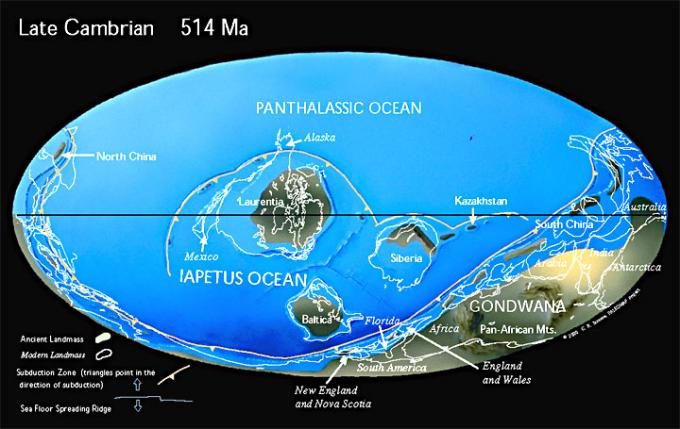Cambrian
The Cambrian is the first geological period of the Paleozoic Era, lasting from 542 ± 0.3 to 488.3 ± 1.7 Mya (ICS, 2004 chart); it is succeeded by the Ordovician. Its subdivisions, and indeed its base, are somewhat in flux. The period was established by Adam Sedgwick, who named it after Cambria, the Latin name for Wales, where Britain's Cambrian rocks are best exposed. It should not be confused with the Cambrian supereon, the current supereon of the planet.
The Cambrian is unique in its unusually high proportion of lagerstätten. These are sites of exceptional preservation, where 'soft' parts of organisms are preserved as well as their more resistant shells. This means that our understanding of the Cambrian biology surpasses that of some later periods.
The Cambrian Period marked a profound change in life on Earth; prior to the Cambrian era, life was on the whole was small and simple. Complex organisms gradually became more common in the millions of years immediately preceding the Cambrian, but it was not until this period that mineralised – hence readily fossilised – organisms became common. This diversification of lifeforms was relatively rapid, and is termed the Cambrian explosion. This vast increase in diverse forms of life produced the first representatives of many modern phyla, representing the evolutionary stems of modern groups of species. While life prospered in the oceans, the land was barren – with nothing more than a microbial 'crud' known as soil crust covering the land. Apart from some tentative evidence suggesting that a few animals foundered around on land, most of the continents resembled deserts spanning from horizon to horizon. Shallow seas flanked the margins of several continents created during the breakup of the supercontinent Pannotia. The seas were relatively warm, and polar ice was absent for much of the period.
Source: http://en.wikipedia.org/wiki/Cambrian | ||
Virtual museum of the Czech Geological Survey, www.geology.cz, (C) Czech Geological Survey, 2011, v.0.99 [13.12.2011]


![[ENG]](img/vlajka-cr.gif) Česky
Česky 
